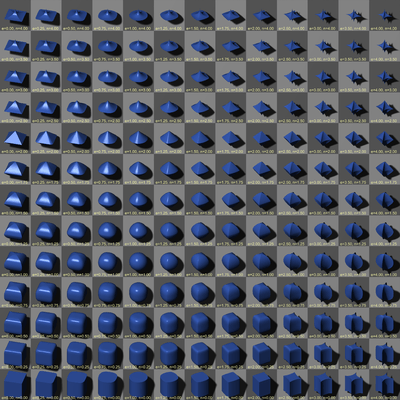Superellipsoid

In mathematics, a super-ellipsoid or superellipsoid is a solid whose horizontal sections are super-ellipses (Lamé curves) with the same exponent r, and whose vertical sections through the center are super-ellipses with the same exponent t.
Super-ellipsoids as computer graphics primitives were popularized by Alan H. Barr (who used the name "superquadrics" to refer to both superellipsoids and supertoroids).[2][3] However, while some super-ellipsoids are superquadrics, neither family is contained in the other.
Piet Hein's supereggs are special cases of super-ellipsoids.
Formulas
Basic shape
The basic super-ellipsoid is defined by the implicit equation
The parameters r and t are positive real numbers that control the amount of flattening at the tips and at the equator. Note that the formula becomes a special case of the superquadric's equation if (and only if) t = r.
Any "parallel of latitude" of the superellipsoid (a horizontal section at any constant z between -1 and +1) is a Lamé curve with exponent r, scaled by  :
:
Any "meridian of longitude" (a section by any vertical plane through the origin) is a Lamé curve with exponent t, stretched horizontally by a factor w that depends on the sectioning plane. Namely, if x = u cos θ and y = u sin θ, for a fixed θ, then
where
In particular, if r is 2, the horizontal cross-sections are circles, and the horizontal stretching w of the vertical sections is 1 for all planes. In that case, the super-ellipsoid is a solid of revolution, obtained by rotating the Lamé curve with exponent t around the vertical axis.
The basic shape above extends from −1 to +1 along each coordinate axis. The general super-ellipsoid is obtained by scaling the basic shape along each axis by factors A, B, C, the semi-diameters of the resulting solid. The implicit equation is
Setting r = 2, t = 2.5, A = B = 3, C = 4 one obtains Piet Hein's superegg.
The general superellipsoid has a parametric representation in terms of surface parameters -π/2 < v < π/2, -π < u < π [3]
where the auxiliary functions are
and the sign function sgn(x) is
The volume inside this surface can be expressed in terms of beta functions, β(m,n) = Γ(m)Γ(n)/Γ(m + n), as
See also
- Super ellipse
References
- ↑ http://www.povray.org/documentation/view/3.6.1/285/
- ↑ Barr, A.H. (January 1981), Superquadrics and Angle-Preserving Transformations. IEEE_CGA vol. 1 no. 1, pp. 11–23
- ↑ 3.0 3.1 Barr, A.H. (1992), Rigid Physically Based Superquadrics. Chapter III.8 of Graphics Gems III, edited by D. Kirk, pp. 137–159
- Jaklič, A., Leonardis, A.,Solina, F., Segmentation and Recovery of Superquadrics. Kluwer Academic Publishers, Dordrecht, 2000.
- Aleš Jaklič and Franc Solina (2003) Moments of Superellipsoids and their Application to Range Image Registration. IEEE TRANSACTIONS ON SYSTEMS, MAN, AND CYBERNETICS, 33 (4). pp. 648–657
External links
- Bibliography: SuperQuadric Representations
- Superquadric Tensor Glyphs
- SuperQuadric Ellipsoids and Toroids, OpenGL Lighting, and Timing
- Superquadratics by Robert Kragler, The Wolfram Demonstrations Project.











